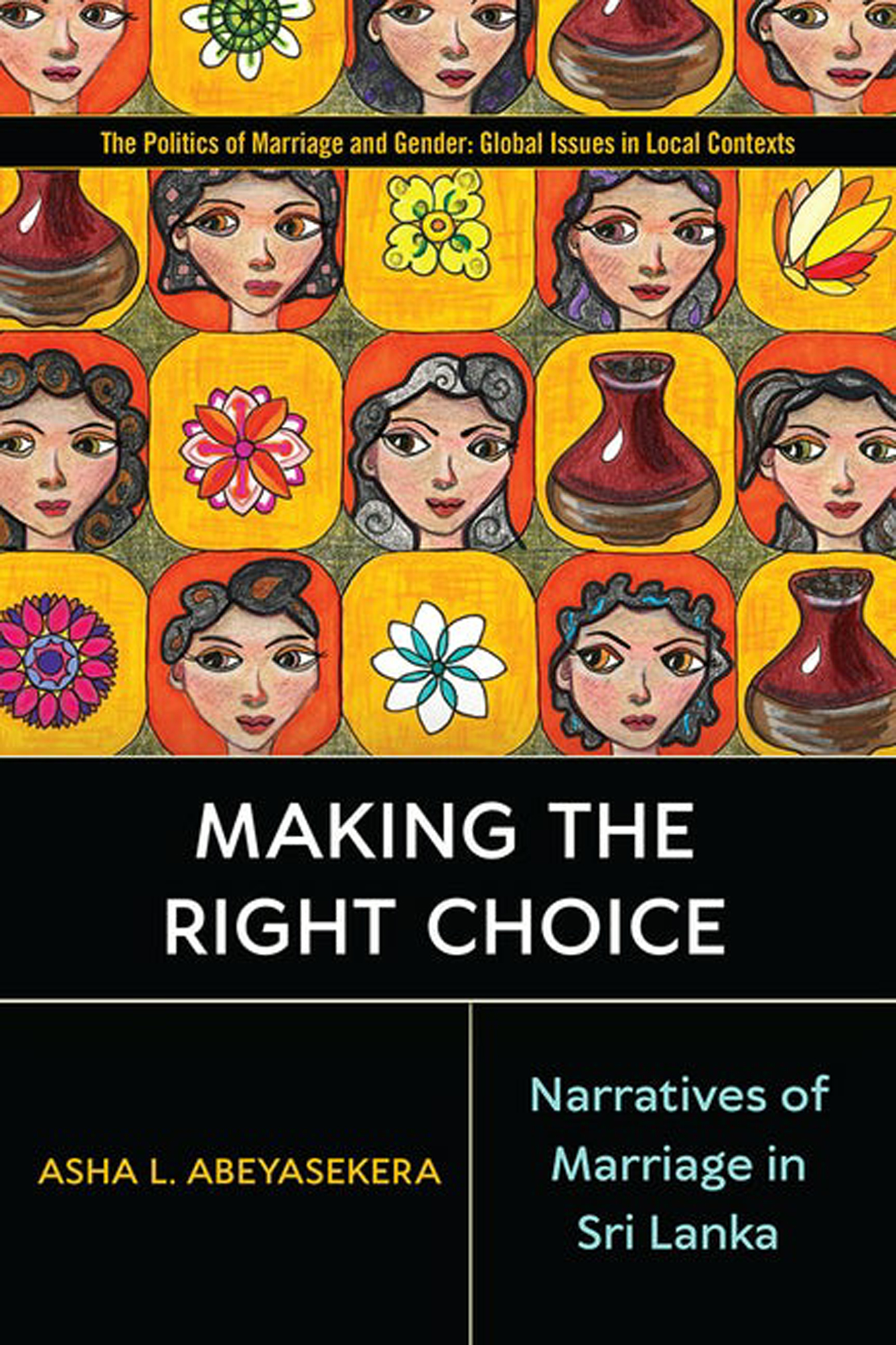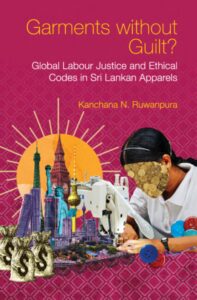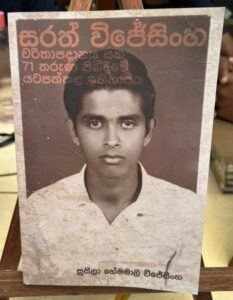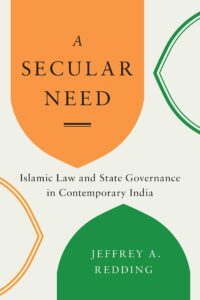Making the Right Choice: Narratives of Marriage in Sri Lanka by Asha L. Abeyasekera (Rutgers University Press, 2021)
 Asha Abeyasekera’s Making the Right Choice: Narratives of Marriage in Sri Lanka (Rutgers University Press, 2021) documents change in marriage practices among the Sinhala-Buddhist urban middle class located in Colombo, Sri Lanka and sets out to “make sense of the entangled relationship between marriage, morality, and the desire for modernity within the specific context of middle-class aspirations for social recognition and upward social mobility” (3). Drawing on life histories of three generations of women from the same family—grandmothers, mothers, and daughters—she examines perceptions and practices around marriage in each generation: marriage choice; organisation of marriages, failed marriages, singleness, and women in divorce courts.
Asha Abeyasekera’s Making the Right Choice: Narratives of Marriage in Sri Lanka (Rutgers University Press, 2021) documents change in marriage practices among the Sinhala-Buddhist urban middle class located in Colombo, Sri Lanka and sets out to “make sense of the entangled relationship between marriage, morality, and the desire for modernity within the specific context of middle-class aspirations for social recognition and upward social mobility” (3). Drawing on life histories of three generations of women from the same family—grandmothers, mothers, and daughters—she examines perceptions and practices around marriage in each generation: marriage choice; organisation of marriages, failed marriages, singleness, and women in divorce courts.
Abeyasekera analyses marriage as a site of kinship obligation and rite of passage into adulthood. It is the duty of parents to ensure that their children are married, and it is a child’s duty to get married. This reciprocal understanding of kinship obligation makes marriage an important milestone for the urban middle class of Colombo. In foregrounding women’s experiences of this milestone, Abeyasekera shows that marriage is particularly central to women’s lives in Sri Lanka. It is part of a woman’s social identity, gives her a sense of belonging and security, and determines success in her life, especially a ‘good’ marriage characterised by stability, reproduction, and a rich network of affective relationships (8). Shaped by Victorian norms of morality introduced to Sri Lanka during colonial rule, marriage also allows women to express their sexuality and experience motherhood legitimately, even if such restrictions were not always the case for Sinhala women.
Social Mobility and Status
Moreover, Abeyasekera shows that marriage is no longer a simple affair but a complex negotiation of sorts that influences social status and social mobility. Taking account of changes brought about after more than 300 years of colonisation and the ‘open economy’ introduced to Sri Lanka in the late 1970s, Abeyasekera deftly explores the relationship between marriage and ideas of social mobility and social status of the urban middle class, and how they are tied to class and caste in particular among the Sinhalese.
In Abeysekera’s analysis, the urban middle class was previously more interested in preserving class compatibilities, status and reputation of the family, and the educational attainment of the chosen spouse, than seeking ethno-religious endogamy (10). However, presently, ethno-religious endogamy is privileged in marriage due to the polarisation of ethnic identities, particularly following the militarisation of the ethnic conflict. Therefore, ethnic similarities are now also a key factor when forming a marriage.
In the context of the discussion around forming marriages, Abeyasekera also weaves a picture of how wedding ceremonies figure as a marker of social status and “globalised modernity”, and their emergence as an industry within the urban middle class in Colombo. She compares how wedding arrangements were made in different generations to show the gradual commercialisation of the event. In a context of capitalism and consumerism, Abeyasekera argues that weddings have become part of a commercial industry involving mega-scale receptions at reputed hotels, beauticians, and photographers capturing memories in story book albums. However, in parallel, families continued to do ‘background checks’ on prospective marriage partners and check the compatibility of horoscopes. Abeyasekera illustrates that modernisation of marriage does not mean that traditional practices have been abandoned, but rather they have been incorporated to suit expectations of modernity.
Women’s Agency
At the centre of this monograph is a discussion about woman’s agency to choose a suitable partner for marriage, and the emergence of what Abeyasekera terms a “choosing self” – a modern woman having agency to choose her marriage partner on her own rather than through an introduction made by the family. Weaving narratives about women’s agency in different generations when choosing a marriage partner, Abeyasekera argues that the ‘good’ or ‘right’ choice is considered to exemplify the modernity that women and their families have gained, but without compromising class compatibilities, status, and reputation of the family.
Thus, Abeyasekera redefines the ideas of love in modern marriages, boldly claiming that ‘choice’ rather than ‘love’ is the defining characteristic of modern marriages (15). For Abeyasekera, love and choice are both structured by notions of respectability that are manifested through acts of responsibility by the individual woman towards herself and her kin. Therefore, making a ‘wrong’ choice is detrimental to the woman and her kin as it would negatively impact on their respectability. Abeyasekera illustrates that women can negotiate their choice with their families when the choice falls short of the family’s expectations, but such ability to negotiate is related to the woman’s education, employment, and independence. However, just as these features of modernity allows women to choose it also holds women accountable to make the right choice.
‘Self-Choice’
Even “self-choice” marriages, that is, marriages that are based on personal preferences and desires, Abeyasekera shows, are collectively influenced by family. Though love, affection, and sexual intimacies are part of the stories told by her interlocutors, women also gave importance to education, wealth, compatibility of horoscopes, and investigating their chosen partner’s family background. These features illuminate how women are concerned about their choice being acceptable to the standards inculcated in them by their families.
Accounts of women who claim to have defied the desires of their families and made the wrong choice speak in tones of regret. Modern urban middle-class women see marriage as a site of risk as marriages are expected to be ‘once and for all’. Therefore, though women and their families consider themselves modern, they cling to the Victorian view of lasting monogamous marriages. Because of such expectations, women have no space to make a mistake. In Sinhala culture, the woman is considered the person to keep marriages intact and afloat even amidst problems because it is her obligation and responsibility.
Therefore, as Abeyasekera notes, the burden is not only in making a choice but continuing with the choice one has made for the rest of one’s life. Yet, by foregrounding choices made rationally, Abeyasekera ignores the palpability of human emotions. In my own work on rural Sri Lanka, it was apparent that the choice of a partner for marriage involved intense emotions in the hope of securing a good life. Abeysekara does not answer if the choice comes first and love afterwards, or if love comes first and informs the choice; and moreover, if the choice can be separated from love or not.
‘Single Women’
Following her discussion of marriage, Abeyasekera goes on to explore narratives of and about women who never married or are ‘single’ women. She narrates the stories of single women to illuminate how women who were never married justify their singleness in terms of value. They choose to be single because they valued their self in different ways. Some value other kin obligations to their families and find belonging with their extended families. They provide financial support or care support to their families that they give more value to, over getting married and raising their own families. Another reason is in valuing education. Women who aspire to pursue higher education are considered unsuitable for marriage because their academic lifestyle is considered incompatible with the domestic life expected in a marriage. The cultural imperative is that a woman’s higher education and marriage can hardly coincide. Consequently, single women justify their singleness as their choice to value education over marriage. Abeyasekera explains that personal childhood experience, insecurities, and anxieties also play a role in choosing to remain single.
Divorce
In portraying narratives of women in divorce courts, Abeyasekera documents the consequential aspects of making a ‘wrong’ choice and failing in marriage. For women, divorce is a vindication from suffering caused by unhappy marriages. Two kinds of divorces are described by Abeyasekera—one that is amicably resolved and the other as a long-drawn-out legal feud.
Divorce signifies the failure of the culturally expected good marriage that a good wife is supposed to build. The failure is attributed to the woman in two ways. She is either the suffering victim or the immoral woman. Abeyasekera describes how the narrative of a divorce case is not only gendered but also classed. Those from higher classes may opt to amicably dissolve the marriage while those from lower classes typically find themselves caught up in legal battles that induce further suffering. Abeyasekera points out that public scrutiny of divorce is gender biased, negatively impacting women more than men. This can be understood as a public punishment for making a wrong choice and failing to fulfil the responsibility entrusted to them. It shows that ‘self-choice’ marriage is not only about kin obligations but also about communal obligations. Society too expects women to be accountable for making the right choice in marriage.
Overall, Abeyasekera’s book provides a lucid and fascinating analysis of modern marriage among the urban middle class of Sri Lanka, illuminating several aspects of marriage hitherto not addressed by scholarship. Writing from a woman’s perspective, Abeyasekera foregrounds the voices of urban Sri Lankan women that have been neglected by social anthropologists such as Edmund Leach ( 1961), Nur Yalman (1967), Gananath Obeyesekere (1967), and S.J. Tambiah (1965) who have chronicled marriage practices as informed by men in rural villages. The book makes the case that no matter how modernity influences women by giving them agency to choose for themselves, unlike for men, women are still bound by the colonial constructions of womanhood that tie their propriety with marriage and compels them to be responsible for the success of their marriage.
Tharindi Udalagama is Senior Lecturer in the Department of Sociology at the University of Colombo.
References
Leach, E. R. (1961). Pul Eliya a Village in Ceylon: A Study of Land tenure and Kinship. Cambridge: Cambridge University Press.
Obeyesekere, G. (1967). Land Tenure in Village Ceylon. Cambridge: Cambridge University Press.
Tambiah, S. J. (1965). “Kinship Fact and Fiction in Relation to the Kandyan Sinhalese.” The Journal of Royal Anthropological Institue, 95(2), 131–173.
Yalman, N. (1967). Under the Bo Tree: Studies in Caste, Kinship and Marriage in the Interior of Ceylon. California: University of California Press.




